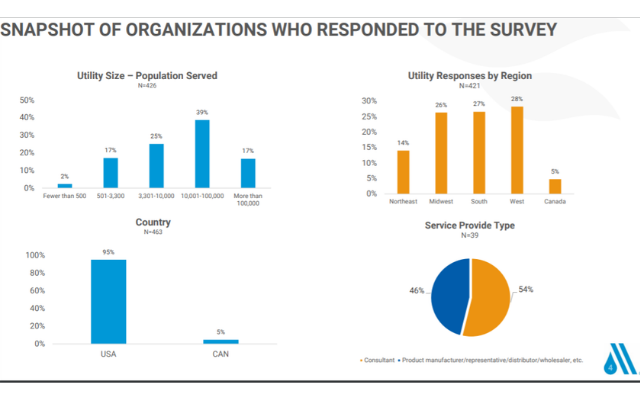Most water utilities are returning to normal operations as they reopen their offices and relax some of the measures they put in place during the first months of the COVID-19 pandemic, according to a recent survey conducted by the American Water Works Association (AWWA).
Conducted June 8-15, this is the fourth in a series of surveys about how AWWA member organizations are adapting to impacts of the COVID-19 pandemic. The survey closed shortly before many communities reported rising cases of COVID-19.
Utilities surveyed also reported the most common challenges were social distancing at the workplace, supply chain disruptions for personal protective equipment (PPE) and declining revenue generation. More than a third (36 percent) of utilities surveyed reported PPE supply chain disruptions and more than one quarter (28 percent) are out N95 masks. This represents a drop from AWWA’s last survey (April 17-22, 2020) when 56 percent of surveyed utilities reported disruptions in PPE supply chain.
The number of utilities that temporarily implemented policies to mitigate COVID-19 risks – shift changes, travel restrictions, remote work where possible — dropped by about 30 percent between AWWA surveys in late April and June. There was also an 11 percent drop in utilities reporting that they suspended water shut-offs between surveys, but still a large majority of utilities have this policy in place (96 percent in April, 85 percent in June).
Seventy-five percent of surveyed utilities say their offices are open (including 21 percent that didn’t close their office at all during the pandemic). These utilities are taking actions to prevent the spread of COVID-19 in the workplace, including implementing enhanced sanitizing procedures (91 percent), reducing size of in-person meetings (76 percent), and requiring face coverings (67 percent).
While PPE supply issues appear to be easing somewhat, the portion of utilities reporting declining revenue generation increased from 23 percent in late April to 32 percent in June. Additionally, 24 percent said they are expecting to see revenue issues in the next month. As a result, 46 percent of utilities have already implemented spending adjustments and another 24 percent said they are considering it.
For the service providers who support the water sector, 46 percent of those surveyed said they are experiencing revenue generation issues and about two-thirds indicate they have implemented spending adjustments. Like utilities, most will have re-opened their offices by the end of June (70 percent); however, service providers are more likely than utilities to maintain policies like work from home and travel restrictions. Service providers have also established policies to help protect their employees from COVID-19, with almost all surveyed reporting enhanced disinfection and sanitizing procedures (94 percent) and about 75 percent implementing flexible work from home policies.
The fourth survey of AWWA member organizations generated 464 responses, including from 421 different utilities and 39 non-utilities (consultants, manufacturers, service providers and others). The responses provide a real-time assessment of how water sector organizations are currently managing impacts of the COVID-19 pandemic.
AWWA offers resources to assist utilities with dealing with the challenges that arise during the pandemic at awwa.org/coronavirus.
Established in 1881, the American Water Works Association is the largest nonprofit, scientific and educational association dedicated to managing and treating water, the world’s most important resource. With approximately 51,000 members, AWWA provides solutions to improve public health, protect the environment, strengthen the economy and enhance our quality of life.




